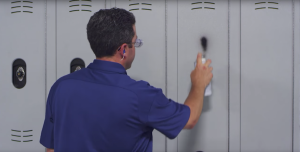As a facility manager of a school, nothing is as stressful as ridding an area in the school of recently applied graffiti. There can be debates of what constitutes as art, but there’s no denying that graffiti is vandalism. While art should be left in the classroom with washable materials being used, you’re tasked with finding ways to combat this problem and ensure that it doesn’t continue. You’ll need to implement a zero-tolerance policy to graffiti vandalism in your school.
Here are a few steps on how to work towards stopping graffiti from popping up in your school.
Communicate with School Administrators About the Costs
As the facility manager of the school, you don’t have any disciplinary sway with the students, so you’ll need to address these issues to the administrators and/or principals. Remind them that graffiti is not only an act of vandalism, but it’s costing you money and time with maintenance. If they can come up with a disciplinary plan that can thwart students from marking up the walls and other components in your school, you’ll begin to see a drop in “artwork” from appearing in your school.
Focus on the Problem Areas
The most common place that you’ll find graffiti is on the toilet partitions. Students with graffiti aspirations use these stalls as their springboard because it’s enclosed and private. However, you can stop graffiti in its tracks by utilizing the right materials for your bathroom.
stalls as their springboard because it’s enclosed and private. However, you can stop graffiti in its tracks by utilizing the right materials for your bathroom.
HDPE plastic toilet partitions are resistant to graffiti. They won’t absorb any paint or permanent marker. Once any mark is made, it can easily be wiped away without having to invest in some fresh paint to coat over the graffiti.
Take Away the Graffiti Hotspots
This step requires you to think like a graffiti artist. You need to look out for easy targets, like blank walls, and even elevated areas that can be viewed by everyone in the school. To combat the students’ desire to tag these spots, beat them to the punch and paint the walls with a darker color that makes it less appealing to spray an image or phrase on.
Update Your Lockers
Lockers are another target area for students to mark up. Since most lockers are made from steel, you’ll have to repaint them once graffiti pops up. However, HDPE plastic can also be used for lockers. This will save you the cost and time that goes into painting, all while updating your schools lockers with a strong, durable, and graffiti-resistant material.
Utilizing HDPE plastic materials has a wide variety of benefits. When it comes to combatting graffiti, these lockers will help you save money and time on maintenance because they resist paint. Once graffiti appears on any HDPE locker or partition, it can easily be wiped away. Want to learn more about HDPE plastic and the many benefits there are to choosing it for your school? Check out this blog post, Why HDPE is a Super Material, from your friends at Scranton Products.
